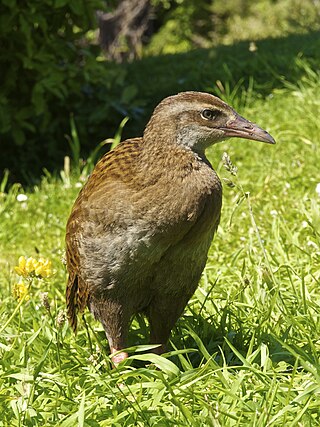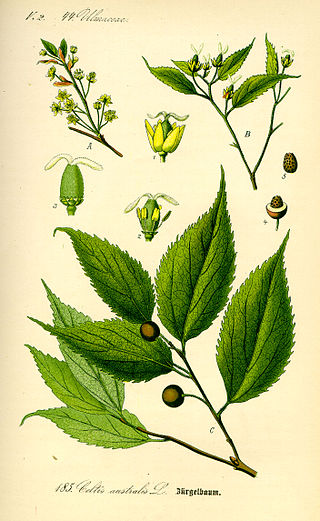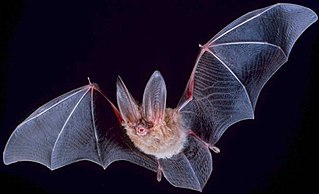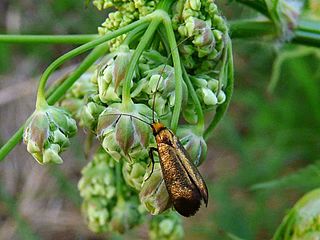
Agathis, commonly known as kauri or dammara, is a genus of 22 species of evergreen tree. The genus is part of the ancient conifer family Araucariaceae, a group once widespread during the Jurassic and Cretaceous periods, but now largely restricted to the Southern Hemisphere except for a number of extant Malesian Agathis.

The weka, also known as the Māori hen or woodhen is a flightless bird species of the rail family. It is endemic to New Zealand. It is the only extant member of the genus Gallirallus. Four subspecies are recognized but only two (northern/southern) are supported by genetic evidence.

Cordyline australis, commonly known as the cabbage tree, tī kōuka or cabbage-palm, is a widely branched monocot tree endemic to New Zealand.

Phragmites is a genus of four species of large perennial reed grasses found in wetlands throughout temperate and tropical regions of the world.

Celtis australis, the European nettle tree, Mediterranean hackberry, lote tree, or honeyberry, is a deciduous tree native to Southern Europe, North Africa, and Asia Minor. The tree was introduced to England in 1796.

The Adelidae or fairy longhorn moths are a family of monotrysian moths in the lepidopteran infraorder Heteroneura. The family was first described by Charles Théophile Bruand d'Uzelle in 1851. Most species have at least partially metallic patterns coloration and are diurnal, sometimes swarming around the tips of branches with an undulating flight. Others are crepuscular and have a drab coloration. Fairy longhorn moths have a wingspan of 4–28 millimeters, and males often have especially long antennae, 1–3 times as long as the forewing.

The green longhorn is a lepidopteran from the moth family Adelidae, the fairy longhorn moths.

Townsend's big-eared bat is a species of vesper bat.

Citrus australis, the Dooja, round lime, Australian lime or Australian round lime, is a large shrub or small tree producing an edible fruit. It grows in forest margins in the Beenleigh area and northwards, in Queensland, Australia.

Phragmites australis, known as the common reed, is a species of plant. It is a broadly distributed wetland grass that can grow up to 20 feet tall.

Epiphryne verriculata, the cabbage tree moth, is a moth in the family Geometridae. It is found only in New Zealand, and only feeds on the native cabbage tree ; its wings are patterned to camouflage it against dead cabbage tree leaves.

Eriocrania unimaculella is a moth of the family Eriocraniidae found in Europe. It was first described by the Swedish naturalist Johan Wilhelm Zetterstedt in 1839. The larvae feed inside the leaves of birch, making a mine.
Queensland tick typhus is a zoonotic disease caused by the bacterium Rickettsia australis. It is transmitted by the ticks Ixodes holocyclus and Ixodes tasmani.

Adela is a genus of the fairy longhorn moth family (Adelidae). Among these, it belongs to subfamily Adelinae.

Adela cuprella is a moth of the family Adelidae and are found in most of Europe. It was first described by Michael Denis & Ignaz Schiffermüller in 1775 and the type locality is from Austria. They can be found flying around sallows (Salix) species during the day in April and May.

Adela septentrionella is a moth of the family Adelidae or fairy longhorn moths. It was described by Walsingham in 1880. It is widespread from southern British Columbia and north-western Idaho to the Transverse Range in southern California.

Adela trigrapha is a moth of the family Adelidae or fairy longhorn moths. It was described by Zeller in 1876 and is found in western North America, from Vancouver Island to California.

Aporophyla australis, the feathered brindle, is a moth in the family Noctuidae. The species was first described by Jean Baptiste Boisduval in 1829. It is found in western and southern Europe, North Africa and the Middle East.

Ceriops australis, the yellow mangrove or smooth-fruited yellow mangrove, is a species of mangrove in the family Rhizophoraceae, native to tropical northern Australia and southern New Guinea. It is a common species in the region and although mangroves are threatened by habitat destruction and climate change, the International Union for Conservation of Nature has assessed its conservation status as being of "least concern".



















